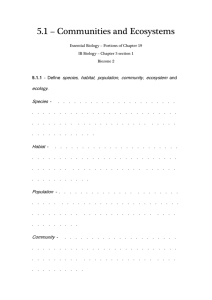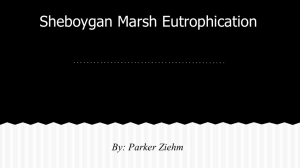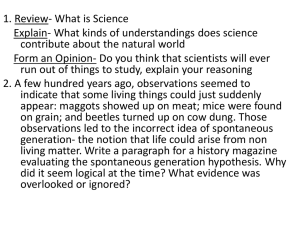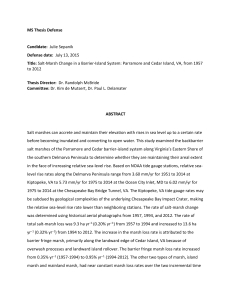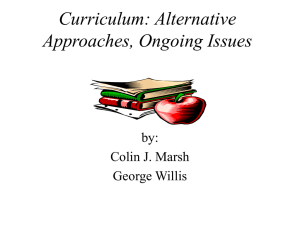DNA, Food Chains, Genetics
advertisement
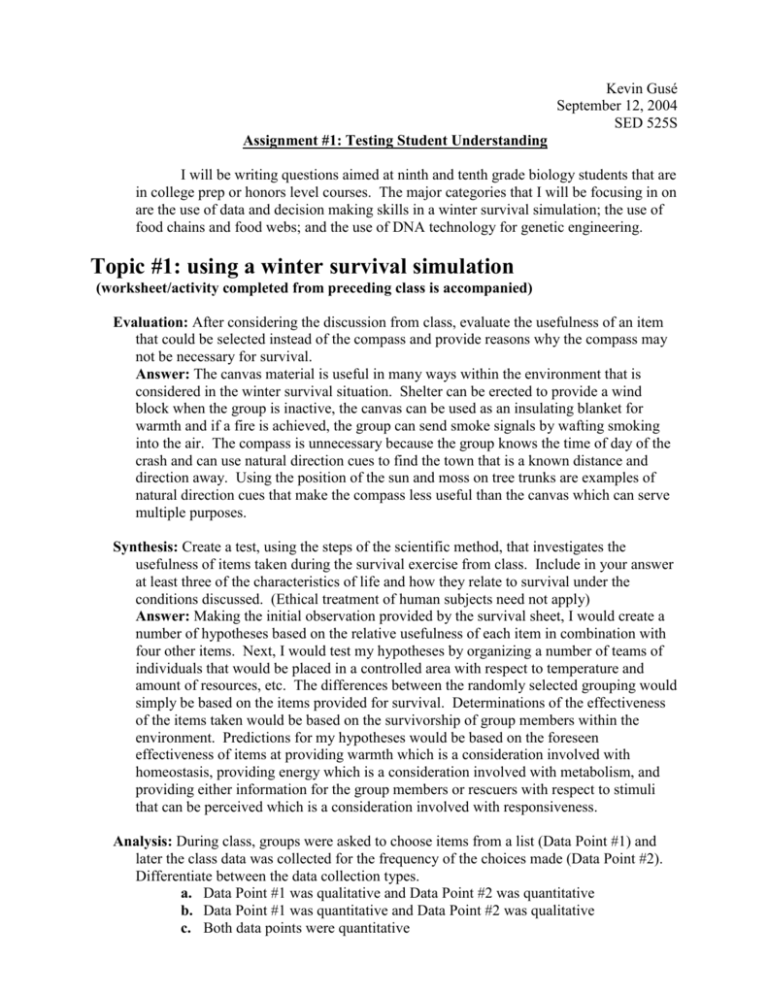
Kevin Gusé September 12, 2004 SED 525S Assignment #1: Testing Student Understanding I will be writing questions aimed at ninth and tenth grade biology students that are in college prep or honors level courses. The major categories that I will be focusing in on are the use of data and decision making skills in a winter survival simulation; the use of food chains and food webs; and the use of DNA technology for genetic engineering. Topic #1: using a winter survival simulation (worksheet/activity completed from preceding class is accompanied) Evaluation: After considering the discussion from class, evaluate the usefulness of an item that could be selected instead of the compass and provide reasons why the compass may not be necessary for survival. Answer: The canvas material is useful in many ways within the environment that is considered in the winter survival situation. Shelter can be erected to provide a wind block when the group is inactive, the canvas can be used as an insulating blanket for warmth and if a fire is achieved, the group can send smoke signals by wafting smoking into the air. The compass is unnecessary because the group knows the time of day of the crash and can use natural direction cues to find the town that is a known distance and direction away. Using the position of the sun and moss on tree trunks are examples of natural direction cues that make the compass less useful than the canvas which can serve multiple purposes. Synthesis: Create a test, using the steps of the scientific method, that investigates the usefulness of items taken during the survival exercise from class. Include in your answer at least three of the characteristics of life and how they relate to survival under the conditions discussed. (Ethical treatment of human subjects need not apply) Answer: Making the initial observation provided by the survival sheet, I would create a number of hypotheses based on the relative usefulness of each item in combination with four other items. Next, I would test my hypotheses by organizing a number of teams of individuals that would be placed in a controlled area with respect to temperature and amount of resources, etc. The differences between the randomly selected grouping would simply be based on the items provided for survival. Determinations of the effectiveness of the items taken would be based on the survivorship of group members within the environment. Predictions for my hypotheses would be based on the foreseen effectiveness of items at providing warmth which is a consideration involved with homeostasis, providing energy which is a consideration involved with metabolism, and providing either information for the group members or rescuers with respect to stimuli that can be perceived which is a consideration involved with responsiveness. Analysis: During class, groups were asked to choose items from a list (Data Point #1) and later the class data was collected for the frequency of the choices made (Data Point #2). Differentiate between the data collection types. a. Data Point #1 was qualitative and Data Point #2 was quantitative b. Data Point #1 was quantitative and Data Point #2 was qualitative c. Both data points were quantitative d. Both data points were qualitative Answer: Data Point #1 was qualitative and Data Point #2 was quantitative Application: Choose the one item that you think is most essential to your survival and discuss how you could use that item in at least three ways within the environment presented. Answer: The canvas is essential to survival. Shelter can be erected to provide a wind block when the group is inactive, the canvas can be used as an insulating blanket for warmth and if a fire is achieved, the group can send smoke signals by wafting smoking into the air. Comprehension: If a group chooses to bring along the following five items select the most probable strategy that the group will use for survival. Items are: sectional air map, compass, extra clothing, can of shortening, chocolate bars. a. The group is going to find the town b. The group is going to signal for help c. The group will hunt for food to provide energy d. The group will erect a shelter for warmth Answer: The group is going to find the town Knowledge: Identify the characteristic of life that is involved with the acquisition and use of energy. a. Homeostasis b. Presence of DNA c. Metabolism d. Presence of cells Answer: Metabolism Topic #2: Use of Food Chains vs. Food Webs Evaluation: Richard Ellis is an ecologist that has been commissioned to eliminate the threat of an exotic salamander from the Maui. The salamander is responsible for the destruction of multiple native plant species, but the newly hatched baby salamanders have become the main food source for many native fish species within area ponds. Judge which technique is best suited for predicting the broad-level ecosystem effects of eliminating the salamanders. a. Dr. Ellis should consider a simple food chain of interactions before acting b. Dr. Ellis should consider a complex food web of interactions before acting c. Dr. Ellis should act without consulting either type of interaction analysis d. All answers are equally correct Answer: Dr. Ellis should consider a complex food web of interactions before acting Synthesis: Using the following data, assemble one food web to describe the interactions that exist between all organisms present and two different potential food chains between at least three different organisms: Grasshoppers provide food for shrews, Harvest Mice and Clapper Rails (small marsh bird); Plankton-eating fish provide food for Herons which also eat mussels that feed on marsh grass that additionally provides food for the grasshoppers and the Clapper Rails; Marsh Hawks feed on Clapper Rails, Shrews, and Harvest Mice. Answer: Food Web Clapper Rail Marsh Hawk Grasshopper Marsh Grass Shrew Harvest Mouse Mussel Plankton Food Chains Marsh Grass Marsh Grass Heron Grasshopper Mussel Shrew Marsh Hawk Heron Analysis: Using the food web from above, compare and contrast the following techniques for increasing the food supply for the decreasing population of Clapper Rails: Increasing the amount of grasshoppers by setting ground traps for the shrews and harvest mice; Increase the amount of marsh grass by eliminating the mussels from the marsh by poisoning. Answer: Limiting the amount of mussels has no effect on predators for the clipper rail while setting traps for the shrews and harvest mice will limit the marsh hawks food supply perhaps shifting its lone food source to the clipper rail which may not work to increase the population numbers, which was the original goal. Application: Using the food web from above, interpret which of the following effects could take place if the Heron no longer lived in the marsh being discussed. a. Plankton population size could increase b. Marsh grass population size could decrease due to increased mussel populations c. Clipper Rail population size could decrease due to decreased grasshoppers and marsh grass populations d. All of the above are possible Answer: All of the above are possible Comprehension: Which of the following best illustrates a food web: a. Single meals between organisms during one day in an ecosystem b. all prey for one organism in an ecosystem c. all predators for one organism in an ecosystem d. predator and prey relationships in an ecosystem Answer: predator and prey relationships in an ecosystem Knowledge: Using the food web from above which of the following animals could be identified as a top predator: a. Clipper Rail b. Mussel c. Marsh Grass d. Heron Answer: Heron Topic #3: Use of DNA technology in genetic engineering Evaluation: Express both sides of the argument used for the development and also the banning of genetically modified crops. Answer: Genetic engineers believe the power of combining the genes between two distinct organisms may enable positive traits from one species to be express in another. Opponents to this technology cite the lack of practice and applied research that has been done in the field and claim that the technology is growing too quickly with little regard for future affects with respect to invasion by exotic organisms which has been seen to cause immeasurable damage in certain ecosystems as well as potential allergenic affects for certain people that may use the products that are potentially going to be created. Synthesis: Understanding that a certain number of bonds hold together complimentary bases within molecules of DNA formulate an equation to account for the number bonds present within a given gene that has a known number of base combination. Identify which variables are being used for the two types of bases connections. Answer: Using the variable x to designate the number of A-T bonds and y to designate the number of C-G bonds, the formula is as follows: # of bonds = 2x + 3y Analysis: Which of the following could represent a valid criticism of the experimental state of genetically modified crop introductions: a. Future generations may not have the ability to stop the spread of “super crops” if they are inherently better at surviving within certain environments. b. Not all hypothetical situations have been explored with respect to the pervasiveness of exotic crops entering into complex ecosystems. c. Genetically modified crops cannot compete with naturally made crops. d. Artificial selection through selective breeding of crops with beneficial traits will prevail over genetically modified crop introductions. Answer: b, all other choices involve conclusions while b investigates the merits of the testing phase of the scientific method. Application: Using the formula 2x + 3y = # of bonds, determine which DNA molecule will have more chemical bonds present. x=A-T bond, y=C-G bond. a. A=30, C=60 b. T=60, G=30 c. G=45, A=45 d. T=15, C=75 Answer: d Comprehension: If a section of DNA is removed from the genome of a rat and replaced by a section of DNA from a fruit fly that contain the same total number of base pairs but relatively less total C-G pairs and relatively more A-T pairs what affect will this have on the number of chemical bonds present? a. # of chemical bonds will increase b. # of chemical bonds will decrease c. # of chemical bonds will stay the same d. All of the above could be correct depending on the method of transference Answer: b Knowledge: Thymine bonds together with which of the following DNA bases a. Cytosine b. Adenine c. Guanine d. Uracil Answer: b

